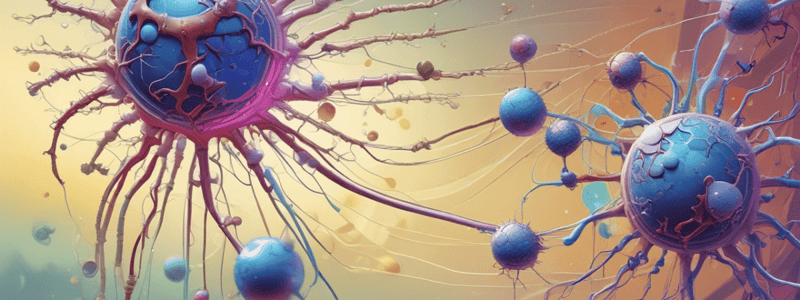Podcast
Questions and Answers
What is the primary function of the thymus in T cell development?
What is the primary function of the thymus in T cell development?
- To educate T cells to recognize self-antigens (correct)
- To provide a site for T cell proliferation and differentiation
- To produce T cells from bone marrow-derived precursors
- To eliminate self-reactive T cells through negative selection
What is the outcome for thymocytes that express a non-functional TCR?
What is the outcome for thymocytes that express a non-functional TCR?
- They become activated and responsive to antigens
- They become regulatory T cells
- They differentiate into CD4+ or CD8+ T cells
- They undergo apoptosis (correct)
What is the primary site of positive selection for self-MHC in the thymus?
What is the primary site of positive selection for self-MHC in the thymus?
- Thymic cortex (correct)
- Bone marrow
- Thymic medulla
- Lymph nodes
What is the role of thymic medullary epithelial cells (TMECs) in T cell development?
What is the role of thymic medullary epithelial cells (TMECs) in T cell development?
What is the outcome for thymocytes that have high affinity for self-MHC?
What is the outcome for thymocytes that have high affinity for self-MHC?
What is the function of CD4 and CD8 accessory molecules in T cell development?
What is the function of CD4 and CD8 accessory molecules in T cell development?
What is the significance of TCR gene rearrangement in T cell development?
What is the significance of TCR gene rearrangement in T cell development?
What is the purpose of thymic education in T cell development?
What is the purpose of thymic education in T cell development?
What role do CD4 T cells primarily perform in the immune response?
What role do CD4 T cells primarily perform in the immune response?
Which mechanism contributes most significantly to the diversity of T Cell Receptors (TCRs)?
Which mechanism contributes most significantly to the diversity of T Cell Receptors (TCRs)?
What is the primary function of antigen presenting cells in the immune system?
What is the primary function of antigen presenting cells in the immune system?
How does immune tolerance relate to autoimmune conditions?
How does immune tolerance relate to autoimmune conditions?
What best describes the process involved in establishing immune tolerance?
What best describes the process involved in establishing immune tolerance?
Which type of T cell is primarily responsible for the direct killing of infected cells?
Which type of T cell is primarily responsible for the direct killing of infected cells?
What impact does TCR diversity have on the recognition of pathogens?
What impact does TCR diversity have on the recognition of pathogens?
What characterizes the adaptive immune response to foreign pathogens?
What characterizes the adaptive immune response to foreign pathogens?
Flashcards are hidden until you start studying
Study Notes
Immune Tolerance and Immune Recognition
- Self/non-self recognition is crucial for the immune system to distinguish between the body's own cells and foreign pathogens.
Main Cellular Players in the Immune Response
- Adaptive immune response involves B cells, CD4 T cells, and CD8 T cells.
- B cells produce antibodies.
- CD4 T cells provide help, while CD8 T cells kill infected cells.
- Antigen-presenting cells, such as dendritic cells (DC) and macrophages, present antigens and kill pathogens.
TCR Diversity and Self-Reactivity
- T-cell receptor (TCR) diversity is generated by gene rearrangement and is estimated to be around 4.5 x 10^9.
- Random TCR diversity makes self-reactivity possible, where CD8+ T cells can kill virus-infected cells or endocrine cells.
Establishing Immune Tolerance
- Immune tolerance prevents autoreactivity while permitting appropriate anti-pathogen responses.
- T cells develop in the thymus, which is seeded by bone marrow-derived precursors and contains organized zones with specialized cell types.
- Thymic education involves T cells acquiring the "tools of the trade," including expression of a functional TCR and CD4 or CD8 receptors.
Thymic Selection
- Positive selection for self-MHC occurs in the thymic cortex, where thymocytes with affinity for MHCII or MHCI express CD4 or CD8, respectively.
- Negative selection eliminates high-affinity self-reactive T cells in the thymic medulla, where thymic medullary epithelial cells (TMECs) express tissue-restricted antigens and induce activation-induced death in T cells with high-affinity receptors.
Immune Tolerance and Autoimmunity
- Immunodeficiency occurs when there is a lack of immune tolerance, while autoimmunity results from a failure of immune tolerance.
Studying That Suits You
Use AI to generate personalized quizzes and flashcards to suit your learning preferences.



